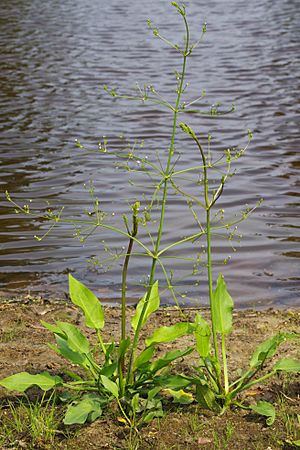European water-plantain facts for kids
Quick facts for kids European water-plantain |
|
|---|---|
 |
|
| Conservation status | |
| Scientific classification | |
| Genus: |
Alisma
|
| Species: |
plantago-aquatica
|
Alisma plantago-aquatica, also known as the European water-plantain or common water-plantain, is a cool flowering plant that grows in water. It's a perennial plant, meaning it lives for more than two years. You can find this plant all over Europe and Asia, from Portugal to Japan. It also grows in parts of northern and central Africa. Sometimes, it has spread to other places like Australia, New Zealand, and parts of North America. This plant loves to grow in shallow water or muddy areas.
Contents
What Does Water-Plantain Look Like?
The water-plantain is a smooth plant that doesn't have hairs. It grows in shallow water. It has roots that look like fibers. From these roots, several long leaves grow, usually about 15 to 30 centimeters (6 to 12 inches) long.
It also has a tall, triangular stem that can reach up to 1 meter (about 3 feet) high. At the top of the stem, there's a branched cluster of many small flowers. Each flower is about 1 centimeter (less than half an inch) wide. They have three round, white, or light purple petals. These flowers usually open in the afternoon. Each flower also has three green sepals (leaf-like parts that protect the bud) and six stamens (the parts that make pollen). The plant flowers from June to August.
The name Alisma comes from an old Celtic word meaning "water." This makes sense because the plant always grows near water! Early scientists named it after the Plantago plant because their leaves looked similar.
Are There Similar Plants?
Yes, there's a plant called the narrow-leaved water-plantain (Alisma lanceolatum). It looks very much like the common water-plantain. The main difference is that its leaves are narrower and come to a sharper point.
How Was Water-Plantain Used in the Past?
Historically, people used water-plantain for different things. Some old books say that a powder made from its dried roots was used in folk medicine. Crushed leaves were also used for certain conditions.
It's important to remember that these were traditional uses. You should never use plants for medicine without talking to a doctor or a healthcare expert first. Some plants, even those used in the past, can be harmful. For example, a plant called Alisma orientale, which is very similar to Alisma plantago-aquatica, has been used in traditional Chinese medicine. However, it can sometimes cause serious problems, especially for people with certain health conditions.
What Do Scientists Say About Water-Plantain?
Scientists are still studying Alisma plantago-aquatica. They do experiments in labs and with animals to see if extracts from the plant or its natural chemicals have any special effects.
Some studies suggest that parts of the plant might:
These studies are just the beginning. More research is needed to understand these potential benefits fully.
See also
 In Spanish: Llantén acuático para niños
In Spanish: Llantén acuático para niños



